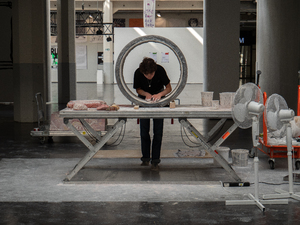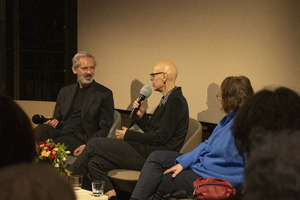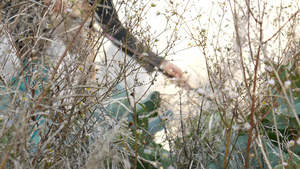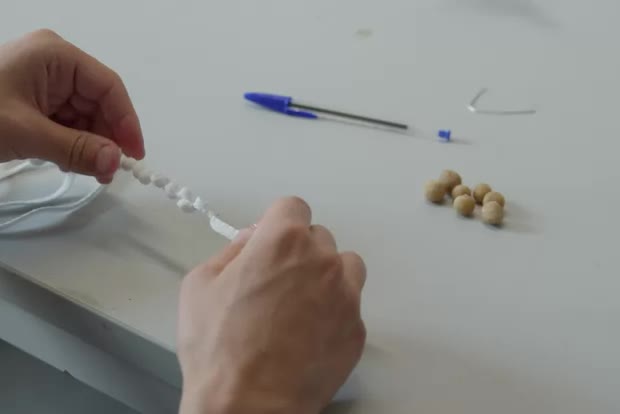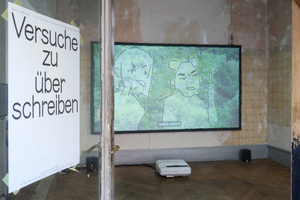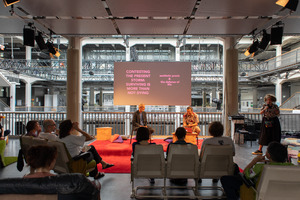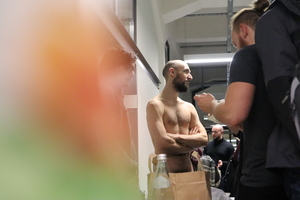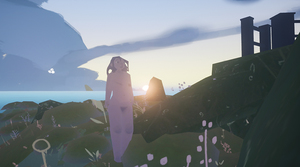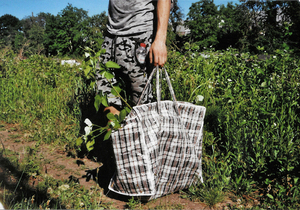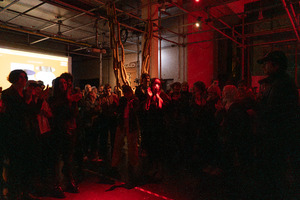Madek Core
Alle Inhalte mit Metadaten des Vokabulars "Madek Core". Sie sehen nur Inhalte, für die Sie berechtigt sind.
269 Inhalte
Filter werden geladen
- Seite 1 von 23
Vordiplom Hannah Gebert
- Titel
- Vordiplom Hannah Gebert
- Titel (en)
- "fake it till you make it"
- Autor/in
- Beschreibung (de)
- Stuckmarmor ist eine historische Stucktechnik des 16. und 17. Jahrhunderts aus Italien, die für ihre Marmorimitation bekannt ist. Dabei wurden Gips, Wasser, Pigmente und tierischer Leim gemischt, um marmorähnliche Oberflächen zu schaffen.
"Fake it till you make it" ist eine Erkundung dieses traditionellen Handwerks. Ziel ist es, die alte Kunst der Marmorimitation wiederzubeleben und ihre ästhetischen Werte in der heutigen Welt zu präsentieren. Darüber hinaus befasst sich das Projekt mit der Frage, was "echt" und was "unecht" ist, und untersucht die Rolle der Inszenierung. Inspiriert von den drei Teilen einer Säule (Basis, Schaft, Kapitell) habe ich drei Objekte entwickelt, die als Einzelstücke im Raum zu finden sind. Alle drei Objekte sind aus Holz gefertigt, zwei davon durch ein Stahlgerüst stabilisiert. Die Unterkonstruktion wurde dann mit Streckmetall verkleidet, verputzt und diente schließlich als Untergrund für den Stuckmarmor. Ein Making-of-Video zeigt die Herstellung des Stuckmarmors. Jedes der Objekte ist auf eine andere Art und Weise verkleidet, um die Konstruktion nicht immer zu verbergen, sondern sie vielmehr zu enthüllen, ganz nach dem Motto "fake it till you make it".
- Stuckmarmor ist eine historische Stucktechnik des 16. und 17. Jahrhunderts aus Italien, die für ihre Marmorimitation bekannt ist. Dabei wurden Gips, Wasser, Pigmente und tierischer Leim gemischt, um marmorähnliche Oberflächen zu schaffen.
- Beschreibung (en)
- Stucco marble is a historic plasterwork technique originating from 16th and 17th-century Italy, celebrated for its imitation of marble. This involved blending gypsum plaster, water, pigments, and animal glue to create marble-like surfaces.
„fake it till you make it“ is an exploration of this traditional craft of stucco marble. The aim is to revive the ancient art of imitating marble and to present its aesthetic values in today‘s world. In addition, the project will address the question of what is „real“ and what is „fake“ and examine the role of staging. Inspired by the three parts of a column (base, shaft, capital) I have developed three objects that can be found as individual pieces in the room. All three objects are made of wood, two of them stabilized by a steel framework. Ribbed expanded metal lath was then stapled onto the wood and plastered, serving as the base for the stucco marble. A making of video shows the production of the stucco marble. Each of the objects is covered in a different way, intended not to always conceal the construction but rather to reveal it, embodying the spirit of „fake it till you make it.“
- Stucco marble is a historic plasterwork technique originating from 16th and 17th-century Italy, celebrated for its imitation of marble. This involved blending gypsum plaster, water, pigments, and animal glue to create marble-like surfaces.
- Kategorie
- Typ des Projekts/Werks
- Schlagworte
- Datierung
- 25.06.2024
- Material
- Ort: Institution
- Ort
- An der Säule unter der Lichtbrücke
- Stadt
- Land
- Titel
- Vordiplom Hannah Gebert
- Projektleiter/in
- Studiengang
- Importiert am
- 22.05.2024
- Übergeordnete Sets
- 1
- Set enthält
- 0 13
Vom Nutzen der Kunst
- Titel
- Vom Nutzen der Kunst
- Titel (en)
- On the benefits of art
- Autor/in
- Beschreibung (de)
- In der gemeinsamen Gesprächsreihe "Vom Nutzen der Kunst" von ZKM und HfG, laden wir internationale Gäste aus Philosophie, Literatur und Kunst zum offenen Austausch mit den Hochschulangehörigen, den Mitarbeitenden des ZKM und der Karlsruher Bevölkerung ein.
- Beschreibung (en)
- In the joint series of talks between ZKM and HfG, we invite international guests from the fields of philosophy, literature and art to an open exchange with members of the university, ZKM staff and the people of Karlsruhe.
- Typ des Projekts/Werks
- Schlagworte
- Datierung
- 16.11.2023
- Ort: Institution
- Ort
- Media Lounge
- Stadt
- Land
- Titel
- Vom Nutzen der Kunst
- Importiert am
- 28.11.2023
- Übergeordnete Sets
- 1
- Set enthält
- 2 0
Visitors
- Titel
- Visitors
- Autor/in
- Beschreibung (en)
- “Visitors” takes as its focus the works of international students from HfG Karlsruhe. The exhibition aims to shed light on the different geographical, political and economic backgrounds that come together in our institution. Two main resources for our work will be HfG's archiving platform Madek and its analogue exhibition interface Portal that the HfG Open Resource Center has been developing.
How do people from abroad who study at the HfG shape the place? How do international students contribute to and challenge the HfG? We will work on preparing and realizing an exhibition based on diploma works of international students from previous generations.
For Visitors we have imagined an alternative geography or an alternative biography of HfG. It is designed around people who ‘visit’ and explore what that challenging gesture means.
- “Visitors” takes as its focus the works of international students from HfG Karlsruhe. The exhibition aims to shed light on the different geographical, political and economic backgrounds that come together in our institution. Two main resources for our work will be HfG's archiving platform Madek and its analogue exhibition interface Portal that the HfG Open Resource Center has been developing.
- Typ des Projekts/Werks
- Mitwirkende
- Sprache
- Titel
- Visitors
- Importiert am
- 27.05.2024
- Übergeordnete Sets
- 1
- Set enthält
- 0 0
Videoarbeiten
- Titel
- Videoarbeiten
- Autor/in
- Titel
- Videoarbeiten
- Semester
- Studiengang
- Typ der Abschlussarbeit
- Importiert am
- 21.08.2023
- Übergeordnete Sets
- 1
- Set enthält
- 0 4
Versuche zu überschreiben
- Titel
- Versuche zu überschreiben
- Titel (en)
- Attempts to rewrite
- Untertitel des Projekts/Werks (en)
- Exhibition with three video works: On the way to the station, Prologue: In the zoo, Germania Girl - Concert in the castle!
- Autor/in
- Beschreibung (de)
- Obszön, nerdy und aus Japan: Anime im Fernsehen zu schauen galt in vielen Haushalten in Deutschland als verrufen. Diese Rezeption von Anime entspricht zugleich den exotisierenden Stereotypen, die der (vorgeblich gesittete) Westen auf Japan projiziert. In ihrer Diplomarbeit nutzt Miki Feller Anime als Medium, um über anti-asiatischen Rassismus zu sprechen. Entstanden sind drei Videoarbeiten, die sie in ihrer Ausstellung „Versuche zu überschreiben“ gezeigt hat. Jedes Video erzählt eine eigene Geschichte, die in Karlsruhe spielt, unter anderem am Bahnhof, am Zoo und am Schloss. Es sind Versuche, eine vorherrschend weiße Umgebung zu beschreiben, sich dazu zu positionieren und davon zu distanzieren.
Die Videos wurden in Zusammenarbeit mit folgenden Personen realisiert und ausgestellt: „Versuche zu überschreiben“ mit Max Mandery (Dramaturgische Beratung), Bruno Jacoby (Grafik), Leia Walz (Ausstellungsgestaltung), Jaya Demmer (Textil), Johannes Thimm und Lina Determann (Rampe) / „Auf dem Weg zum Bahnhof“ mit Bruno Jacoby (Grafik) / „Prolog: Im Zoo“ mit Sophia Stadler (Storyboard, Schnitt & Fotos) / „Germania Girl – Konzert im Schloss!“ mit Max Mandery (Dramaturgische Beratung), Bruno Jacoby (Grafik), Yun-Wen Liu (Fotos & Farbkorrektur), Vanessa Bosch (Musik), Ricarda Fischer (Musik & Sounddesign), Meret Bhend und Paulina Mimberg (Farbkorrektur), Luise Peschko (Dialog Editing) sowie Nele Faust, Alejandra Janus, Melanie Berner, Rita Andrulyte, Nini Lü, Jörg Stegmann, Laura Haak und Josefine Scheu (Stimmen).
- Obszön, nerdy und aus Japan: Anime im Fernsehen zu schauen galt in vielen Haushalten in Deutschland als verrufen. Diese Rezeption von Anime entspricht zugleich den exotisierenden Stereotypen, die der (vorgeblich gesittete) Westen auf Japan projiziert. In ihrer Diplomarbeit nutzt Miki Feller Anime als Medium, um über anti-asiatischen Rassismus zu sprechen. Entstanden sind drei Videoarbeiten, die sie in ihrer Ausstellung „Versuche zu überschreiben“ gezeigt hat. Jedes Video erzählt eine eigene Geschichte, die in Karlsruhe spielt, unter anderem am Bahnhof, am Zoo und am Schloss. Es sind Versuche, eine vorherrschend weiße Umgebung zu beschreiben, sich dazu zu positionieren und davon zu distanzieren.
- Beschreibung (en)
- Obscene, nerdy, and from Japan: In many German households, it was forbidden to watch anime on television. This perception of anime mirrors the exoticizing stereotypes projected onto Japan by the (allegedly civilized) West. In her diploma project, Miki Feller addresses anti-Asian racism in Germany by using anime as the medium. She created three video works and showcased them in the exhibition “Versuche zu überschreiben.” Each video tells a story set in Karlsruhe, for example, at the train station, the zoo, and the castle. These videos serve as attempts to describe a predominantly white environment, to position oneself in relation to it, and to distance oneself from it.
The videos were created and presented in collaboration with the following people: "Versuche zu überschreiben" with Max Mandery (dramaturgical consultation), Bruno Jacoby (graphics), Leia Walz (exhibition design), Jaya Demmer (textile), Johannes Thimm and Lina Determann (ramp) / "Auf dem Weg zum Bahnhof" with Bruno Jacoby (graphics) / "Prolog: Im Zoo" with Sophia Stadler (storyboard, editing & photos) / "Germania Girl - Konzert im Schloss!" with Max Mandery (dramaturgical consultation), Bruno Jacoby (graphics), Yun-Wen Liu (photos & color grading), Vanessa Bosch (music), Ricarda Fischer (music & sound design), Meret Bhend and Paulina Mimberg (color grading), Luise Peschko (dialog editing) as well as Nele Faust, Alejandra Janus, Melanie Berner, Rita Andrulyte, Nini Lü, Jörg Stegmann, Laura Haak, and Josefine Scheu (voice acting).
- Obscene, nerdy, and from Japan: In many German households, it was forbidden to watch anime on television. This perception of anime mirrors the exoticizing stereotypes projected onto Japan by the (allegedly civilized) West. In her diploma project, Miki Feller addresses anti-Asian racism in Germany by using anime as the medium. She created three video works and showcased them in the exhibition “Versuche zu überschreiben.” Each video tells a story set in Karlsruhe, for example, at the train station, the zoo, and the castle. These videos serve as attempts to describe a predominantly white environment, to position oneself in relation to it, and to distance oneself from it.
- Typ des Projekts/Werks
- Schlagworte
- Datierung
- 22.09.2023 - 24.09.2023
- Mitwirkende
- Dank an
- Sprache
- Ort: Institution
- Stadt
- Land
- Titel
- Versuche zu überschreiben
- Projektleiter/in
- Semester
- Studiengang
- Typ der Abschlussarbeit
- Importiert am
- 04.03.2024
- Übergeordnete Sets
- 1
- Set enthält
- 0 9
Veranstaltungen
Vakna - Diplompräsentation
- Titel
- Vakna - Diplompräsentation
- Untertitel
- Der menschliche Körper. Das Wiederentdecken. Das Akzeptieren. Das Erwachen
- Autor/in
- Beschreibung (de)
- Vakna ist ein Spiel, das die Reise in das eigene (von der Gesellschaft beeinflusste) Denken ermöglicht und sowohl das Denken selbst als auch die eigenen Verhaltensweisen und eigenen Gefühle zum unbekleideten, menschlichen Körper hinterfragt.
Die Diplompräsentation wurde demzufolge ohne bedeckende, verdeckende, versteckende, verkleidende und betäubende Kleidung gehalten. Auch die Gestaltung der Räumlichkeiten wurde auf eine Weise vorbereitet, sodass eine Verbindung zur Diplomarbeit hergestellt und vor Ort ein Hinterfragen und Erleben mit den Sinnen stattfinden konnte.
- Vakna ist ein Spiel, das die Reise in das eigene (von der Gesellschaft beeinflusste) Denken ermöglicht und sowohl das Denken selbst als auch die eigenen Verhaltensweisen und eigenen Gefühle zum unbekleideten, menschlichen Körper hinterfragt.
- Ort
- HfG Karlsruhe
- Internetlinks
- Titel
- Vakna - Diplompräsentation
- Semester
- Importiert am
- 17.12.2018
- Übergeordnete Sets
- 1
- Set enthält
- 0 27
Vakna
- Titel
- Vakna
- Titel (en)
- Vakna
- Untertitel
- Der menschliche Körper. Das Wiederentdecken. Das Akzeptieren. Das Erwachen
- Autor/in
- Beschreibung (de)
- Der menschliche Körper.
Das Wiederentdecken.
Das Akzeptieren.
Das Erwachen.
Diese Gedanken sind der Beginn des Spiels Vakna, einer Gedankenwelt, die sich mit der Wahrnehmung und der Akzeptanz des unbekleideten menschlichen Körpers befasst und dadurch gesellschaftliche Einflüsse hinterfragt.
In dieser Gedankenwelt ist es dem/der Spieler/in möglich durch auffindbare Fragen und Aussagen mehr über sich selbst, die eigene Wahrnehmung, das eigene Verhalten, die eigene Moral und die eigenen rituellen Gedankengänge den menschlichen Körper betreffend herauszufinden.
Die Gedankenwelt Vakna erwacht gemeinsam mit der spielenden Person, welche vielleicht beginnt die eigene Wahrnehmung, das eigene Verhalten, die eigene Moral und die eigenen rituellen Gedankengänge den menschlichen Körper betreffend zu hinterfragen, für sich selbst und gegenüber anderen Menschen neu zu ordnen oder zu verändern.
Am Ende dieses Spiels hat jede Person für sich selbst zu entscheiden, ob das Wiedererwachen des Körpers und damit verbundene „Neu-Erleben“ der Welt ausprobiert oder gelebt werden möchte.
Auch sind die Fragen zu beantworten, wie mit der neugewonnen Akzeptanz und Wiederentdeckung umzugehen ist. Doch hat die spielende Person bei dieser Entscheidung sich nicht dem Spiel gegenüber zu verantworten, sondern sich selbst und den Mitmenschen der Gesellschaft.
Bei diesem Computerspiel handelt es sich um einen Single-Player im Bereich der Serious- und Educational-Games, das mit Tastatur und Maus gespielt werden kann.
- Der menschliche Körper.
- Beschreibung (en)
- The human Body.
The Rediscovery.
The Accepting.
The Awakening.
These thoughts are the beginning of the game Vakna, a world of thoughts that deals with the perception and acceptance of the human body without clothes, thereby questioning social influences.
In this world of thoughts it is possible for the player to find out more about himself, his own perception, his own behavior, his own morality and his own ritual thoughts concerning the human body through discoverable questions and statements.
Vakna awakens together with the player. The player begins to question the own perception, the own behavior, the own morality and the own ritual thought processes concerning the human body and perhaps to rearrange or change them for themselves and for other people.
At the end of this game, each person has to decide for himself whether the body's reawakening and the „re-experiencing“ of the world would be tried out or lived.
Also, the questions to be answered are how to deal with the newly gained acceptance and rediscovery. But in this decision, the player does not have to answer to the game, but to himself and the fellow human beings of society.
This computer game is a single player in the field of serious and educational games that can be played with a keyboard and a mouse.
- The human Body.
- Typ des Projekts/Werks
- Schlagworte
- Datierung
- 21.11.2018
- Mitwirkende
- Sprache
- Material
- Technik/Verfahren/Formate
- Computerspiel für Windows
- Abmessungen
- 3D
- Ort
- Hochschule für Gestaltung Karlsruhe
- Stadt
- Land
- Internetlinks
- Titel
- Vakna
- Importiert am
- 16.11.2018
- Übergeordnete Sets
- 1
- Set enthält
- 1 21
Ungeordnete Zustände
- Titel
- Ungeordnete Zustände
- Titel (en)
- Disorderly Conditions
- Untertitel
- Abtrag I Fragmentierung I Zerfall I Austrag I Verschwinden: Kleingärten an der Stuttgarter Straße Karlsruhe
- Untertitel des Projekts/Werks (en)
- Removal I Fragmentation I Decay I Dismantling I Disappearance: Allotment gardens on Stuttgarter Straße in Karlsruhe
- Autor/in
- Beschreibung (de)
- Die Ausstellung "Ungeordnete Zustände" erzählt in unterschiedlichen Strängen von der Auflösung der Kleingärten an der Stuttgarter Straße in Karlsruhe. Leonie Mühlen beobachtete diese Bewegungen, dokumentierte sie und nahm selbst daran teil. Die gezeigte Sammlung ist ein Versuch den Ort zu begreifen und zu konservieren. Eben diesen Ort im Abbruch, der in seiner Unordnung und seinem Ungehorsam Refugium für viele Dinge und Wesen war.
- Beschreibung (en)
- The exhibition "Ungeordnete Zustände" tells the story of the dissolution of the allotment gardens on Stuttgarter Straße in Karlsruhe in various strands. Leonie Mühlen observed these movements, documented them and took part in them herself. The collection on display is an attempt to understand and preserve the place. Precisely this place in demolition, which in its disorder and disobedience was a refuge for many things and beings.
- Kategorie
- Schlagworte
- Datierung
- 09.06.2021 - 27.06.2021
- Mitwirkende
- Ort: Institution
- Ort
- Luisenstraße 32
- Stadt
- Land
- Titel
- Ungeordnete Zustände
- Projektleiter/in
- Semester
- Studiengang
- Typ der Abschlussarbeit
- Importiert am
- 17.06.2024
- Übergeordnete Sets
- 1
- Set enthält
- 2 17
UMBAU Launch 3: Chaining
- Titel
- UMBAU Launch 3: Chaining
- Internetlinks
- Titel
- UMBAU Launch 3: Chaining
- Importiert am
- 15.01.2025
- Übergeordnete Sets
- 2
- Set enthält
- 0 25
UMBAU Issue 3 Celebration
- Titel
- UMBAU Issue 3 Celebration
- Autor/in
- Beschreibung (de)
- Thursday our HfG online Journal UMBAU will celebrate it's 3rd Issue called CHAINING.
8pm / 18.01.24 / at HfG Forum
There will be a performance by the artist Elle Fierce at 20:30 They are a Trans Non-Binary, British born Jamaican-Irish artist and activist, classically trained in ballet and modern dance, and have performed on stages around the world, particularly in the UK and most recently as a Soloist at Oper Leipzig. Now a freelance artist, with a multi disciplinary approach to performance, combining their activism and life experience as a black trans body to create provocative works.
The event shows artworks by Lucia Mattes and Lars Pinkwart and hosts afterwards DJ sets by aswesome LaLa Tina and our very best Frankie Spiderweb.
Our first contributions feature Mascha Dilger, Matteo Pasquinelli and Ülkü Süngün.
With unchained hearts, your UMBAU Team // Paolo Caffoni, Charlotte Eifler, Yannick Fritz, Jule Köpke & Livia Lazzarini
- Thursday our HfG online Journal UMBAU will celebrate it's 3rd Issue called CHAINING.
- Beschreibung (en)
- Thursday our HfG online Journal UMBAU will celebrate it's 3rd Issue called CHAINING.
8pm / 18.01.24 / at HfG Forum
There will be a performance by the artist Elle Fierce at 20:30 They are a Trans Non-Binary, British born Jamaican-Irish artist and activist, classically trained in ballet and modern dance, and have performed on stages around the world, particularly in the UK and most recently as a Soloist at Oper Leipzig. Now a freelance artist, with a multi disciplinary approach to performance, combining their activism and life experience as a black trans body to create provocative works.
The event shows artworks by Lucia Mattes and Lars Pinkwart and hosts afterwards DJ sets by aswesome LaLa Tina and our very best Frankie Spiderweb.
Our first contributions feature Mascha Dilger, Matteo Pasquinelli and Ülkü Süngün.
With unchained hearts, your UMBAU Team // Paolo Caffoni, Charlotte Eifler, Yannick Fritz, Jule Köpke & Livia Lazzarini
- Thursday our HfG online Journal UMBAU will celebrate it's 3rd Issue called CHAINING.
- Schlagworte
- Datierung
- 18.01.2024
- Mitwirkende
- Ort: Institution
- Ort
- HfG Forum
- Stadt
- Land
- Internetlinks
- Titel
- UMBAU Issue 3 Celebration
- Importiert am
- 20.02.2024
- Übergeordnete Sets
- 0
- Set enthält
- 0 25
